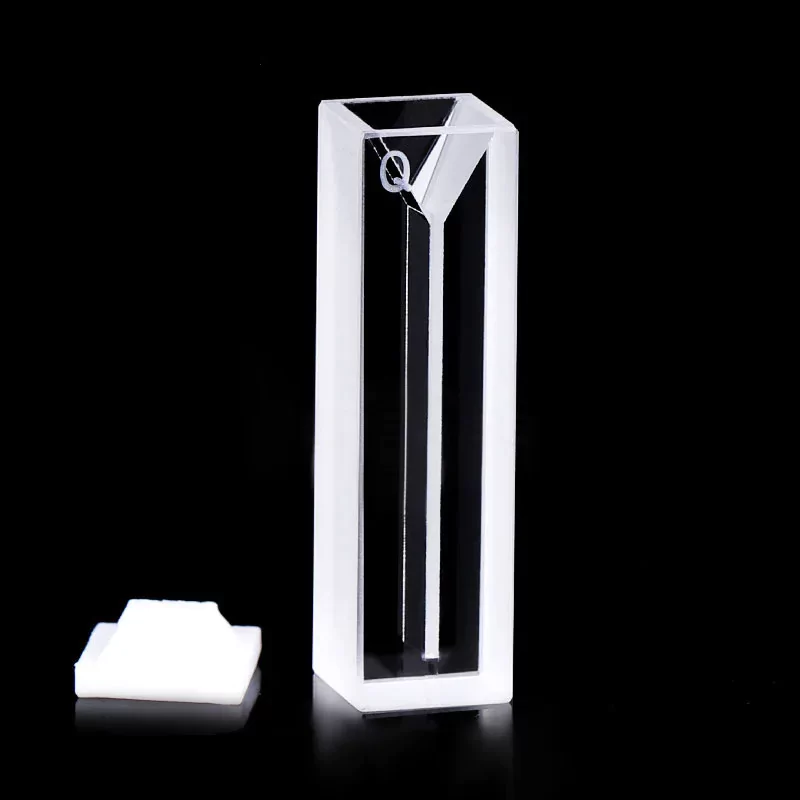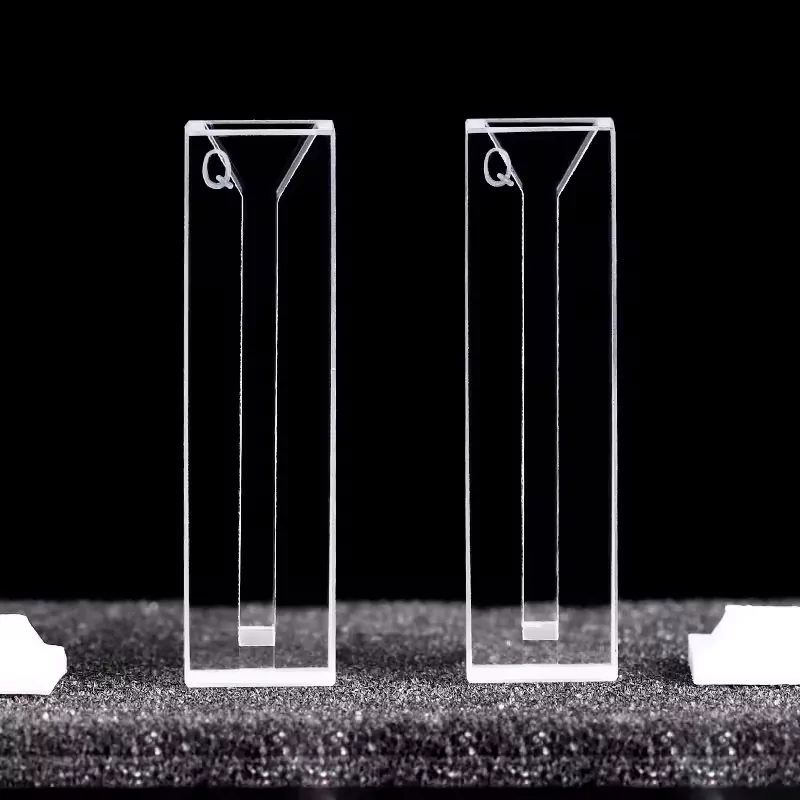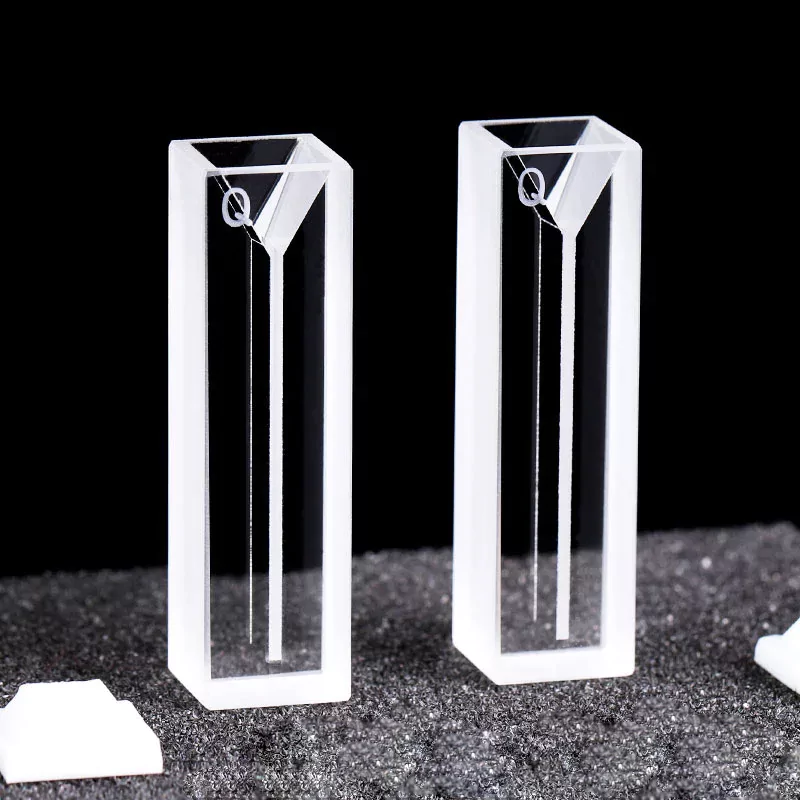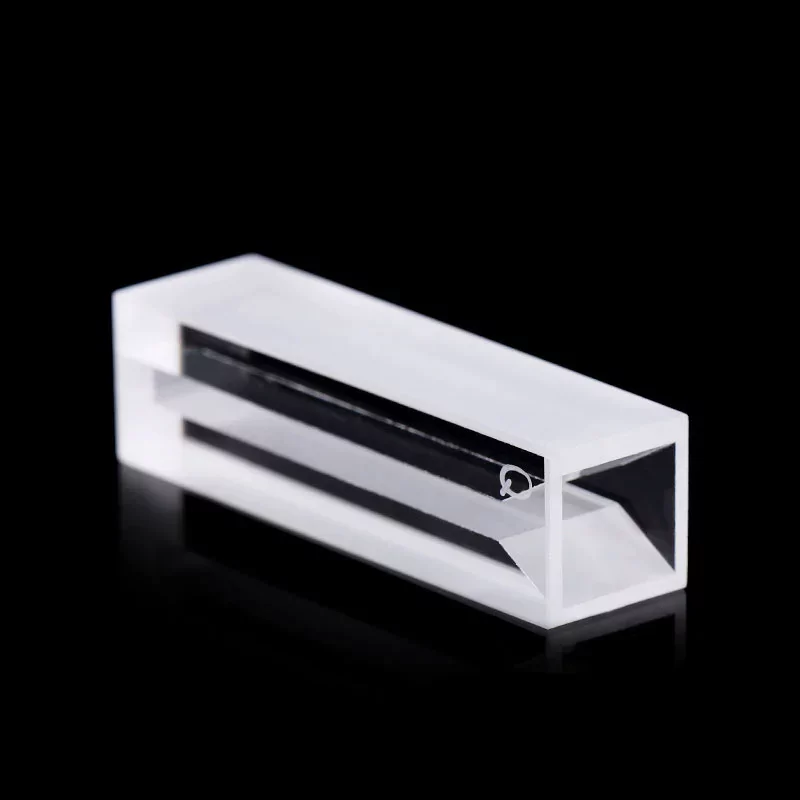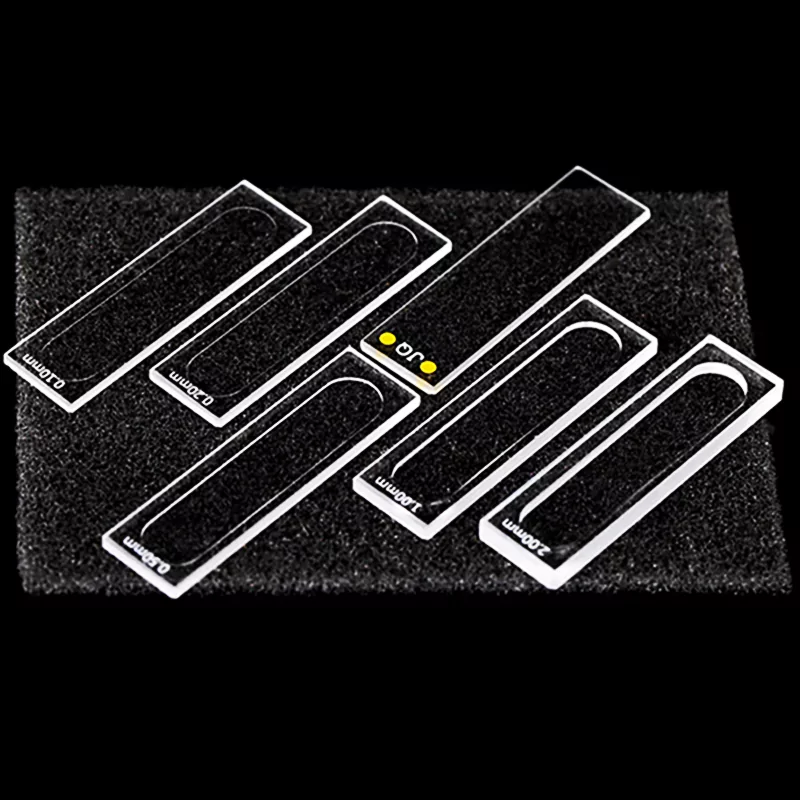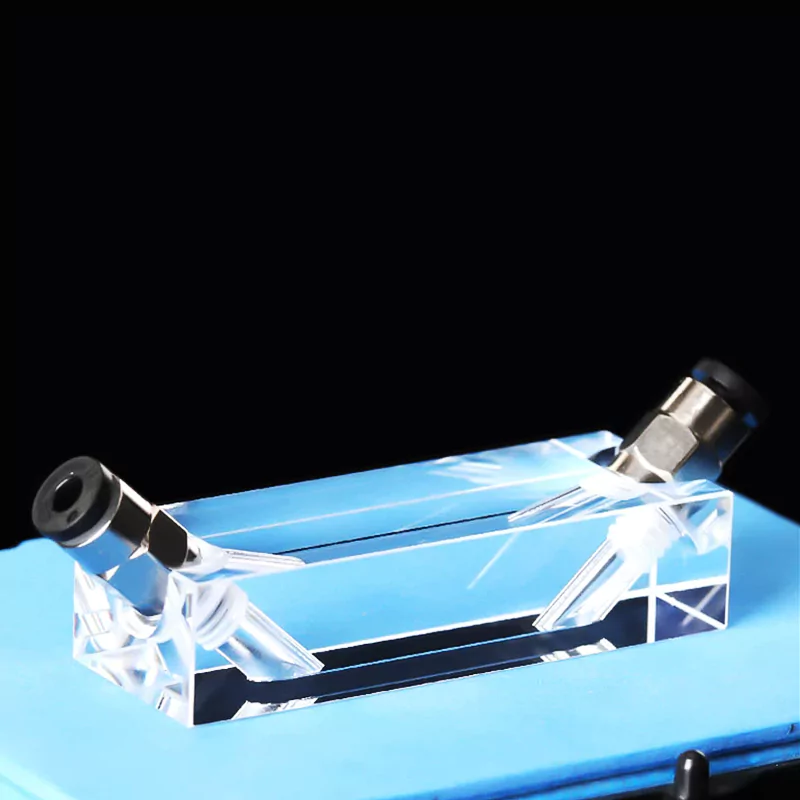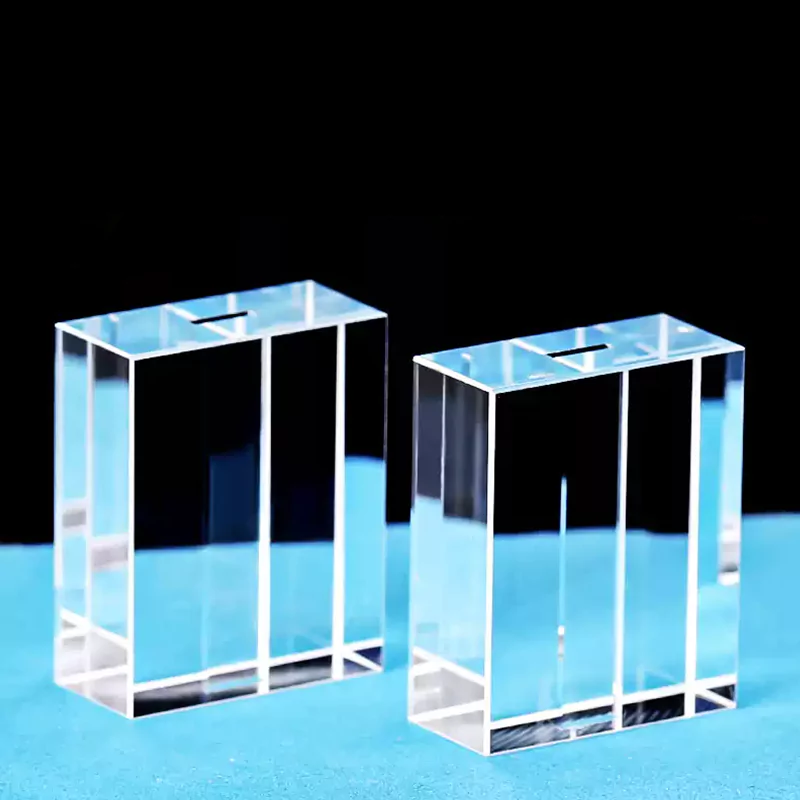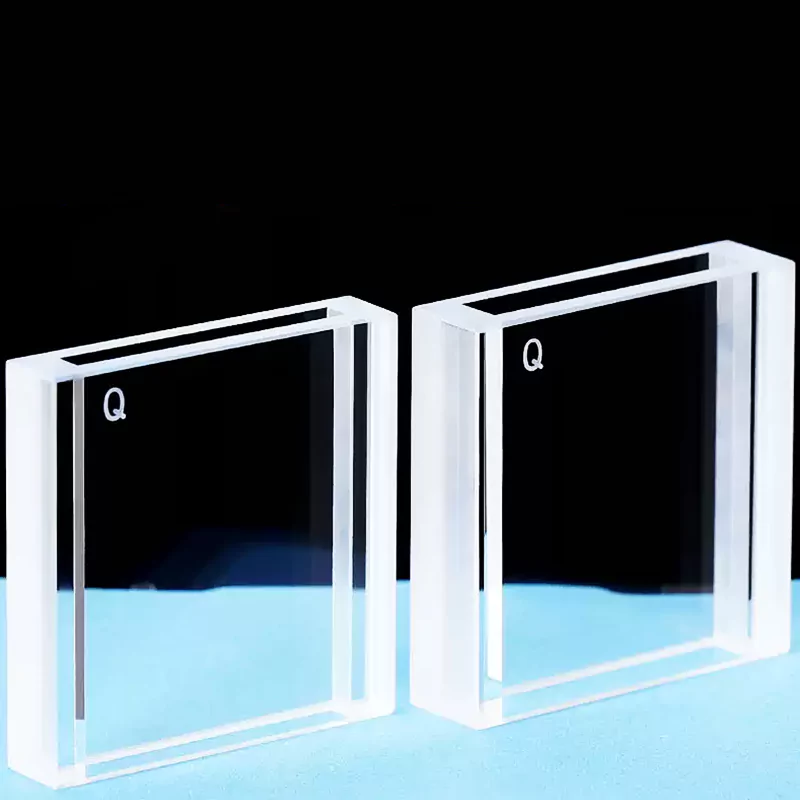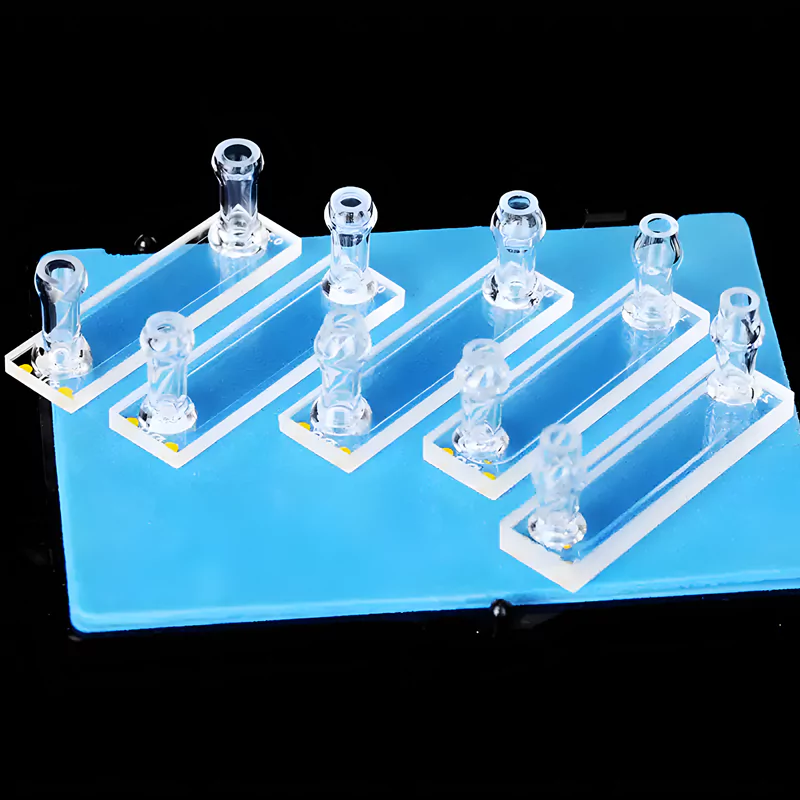- Home
- /
- Types
- /
- Quartz Cuvette
- /
- Quartz UV Cuvette
- /
- Fused Quartz Micro UV...
Fused Quartz Micro UV Cuvette with Lid for UV-Vis Spectroscopy -TOQUARTZ®
Available in multiple volume options from 350μl to 1750μl with standard 10mm path length.
Features of Quartz Micro UV Cuvette with Lid
TOQUARTZ® Fused Quartz Micro UV Cuvettes are engineered for precision optical measurements in laboratory environments. These high-quality cuvettes offer superior performance characteristics ideal for analytical spectroscopy applications.
Optical Transmission
Superior transmission across 200-2500nm wavelength range with >80% paired testing transmittance.
Chemical Resistance
Stable against acids, alkalis, salt solutions, and fluorinated gases for broad experimental applications.
Thermal Stability
Withstands temperatures up to 1100°C with low thermal expansion coefficient (5.5×10⁻⁷/°C).

- Wide Spectral Range (200-2500nm)
- Thermal Stability (1100°C+)
- Custom Design Support
Technical Specifications & Dimensions of
Fused Quartz Micro UV Cuvette with Lid
Technical Specifications of Quartz Glass Micro UV Cuvette with Lid
| Property | Value / Description |
| Material Purity | ≥ 99.995% SiO₂ (Fused Quartz) |
| UV-Vis Transmission Range | 200 nm – 2500 nm |
| Transmittance at 260 nm | > 85% (single window), > 80% (paired cuvette) |
| Refractive Index (at 589 nm) | 1.4585 |
| Thermal Stability | Up to 1100°C continuous use |
| Thermal Shock Resistance | ΔT ≥ 250°C (no cracking under rapid temperature change) |
| Thermal Conductivity | 1.4 W/m·K (at 20°C) |
| Coefficient of Thermal Expansion | 5.5 × 10⁻⁷ /°C (20–300°C) |
| Specific Heat Capacity | 670 J/kg·K (at 20°C) |
| Density | 2.2 g/cm³ |
| Dielectric Strength | 250–400 kV/cm |
| Chemical Resistance | Excellent resistance to acids, bases, organic solvents (except HF) |
| pH Stability Range | pH 1 – 14 (tested in buffer solutions, 100 cycles) |
| Surface Roughness (Optical Face) | Ra < 0.01 μm (polished, non-porous) |
| Solvent Compatibility | Compatible with ethanol, methanol, acetone, DMSO, acetonitrile, NaOH, HCl, etc. |
| Fluorescence Background | Negligible autofluorescence under 260–320 nm excitation |
| Hydrolytic Resistance | Class 1 (ISO 719) |
| Acid Resistance Class | Class 1 (ISO 1776) |
| Alkali Resistance Class | Class 2 (ISO 695) |
Size of of Fused Quartz Micro UV Cuvette with Lid
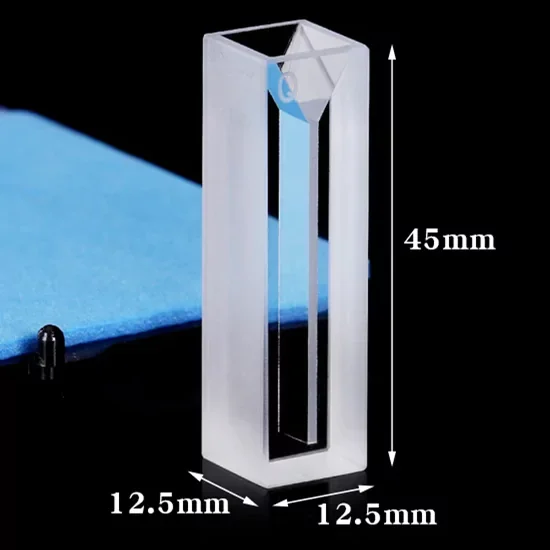
| Model | Description | Wavelength | Path Length | Volume | Transmittance | Outline Dimension |
| AT-BSM-014 | 350μl Fused Quartz Micro UV Cuvette with Lid | 200nm-2500nm | 10mm | 350μl | >80% (Paired Testing) | 12.5×12.5x45mm |
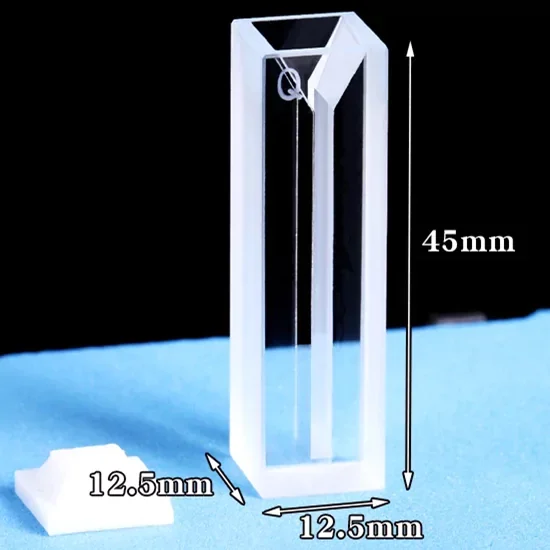
| Model | Description | Wavelength | Path Length | Volume | Transmittance | Outline Dimension |
| AT-BSM-012 | 700μl Fused Quartz Micro UV Cuvette with Lid | 200nm-2500nm | 10mm | 700μl | >80% (Paired Testing) | 12.5×12.5x45mm |
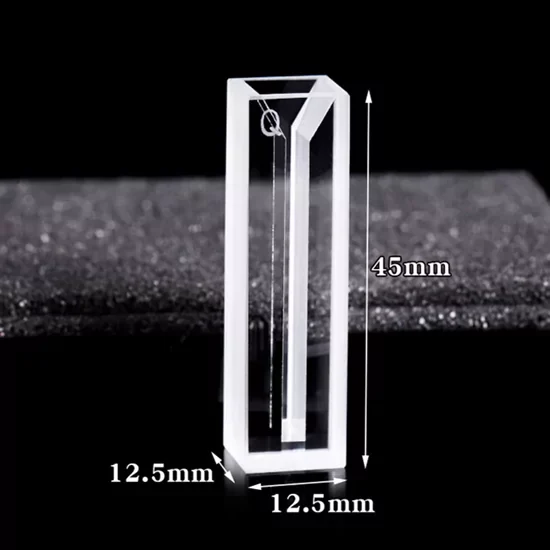
| Model | Description | Wavelength | Path Length | Volume | Transmittance | Outline Dimension |
| AT-BSM-016 | 1050μl Fused Quartz Micro UV Cuvette with Lid | 200nm-2500nm | 10mm | 1050μl | >80% (Paired Testing) | 12.5×12.5x45mm |
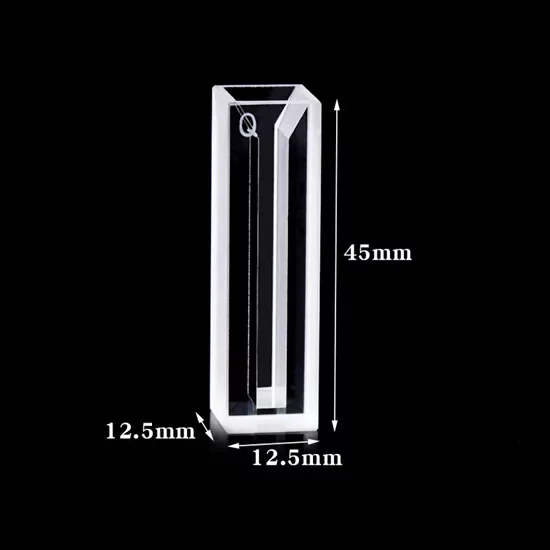
| Model | Description | Wavelength | Path Length | Volume | Transmittance | Outline Dimension |
| AT-BSM-018 | 1400μl Fused Quartz Micro UV Cuvette with Lid | 200nm-2500nm | 10mm | 1400μl | >80% (Paired Testing) | 12.5×12.5x45mm |

| Model | Description | Wavelength | Path Length | Volume | Transmittance | Outline Dimension |
| AT-BSM-075 | 1750μl Fused Quartz Micro UV Cuvette with Lid | 200nm-2500nm | 10mm | 1750μl | >80% (Paired Testing) | 12.5×12.5x45mm |
Solutions for UV Spectroscopy Applications Using
Fused Quartz Micro UV Cuvette with Lid
UV Fused Quartz Micro Cuvette with Lid for Precise DNA/RNA Quantification
Key Advantages
-
Path Length Deviation < ±0.05mm
Minimizes absorbance error at 260nm, ensuring <2% variation in A260/A280 ratio across replicates. -
UV-Optimized Optical Windows
Delivers >85% transmittance at 260nm with <0.5% baseline drift during 30-minute continuous reads.
TOQUARTZ® solution
A US-based research institute reported inconsistent A260/A280 ratios when using standard plastic cuvettes, with measurement variations exceeding 12%.
After switching to TOQUARTZ® Fused Quartz Micro UV Cuvettes, they achieved consistent readings with variation reduced to under 2%, significantly improving downstream application success rates.
UV Quartz Glass Micro Cuvette with Lid for Spectrophotometer Instrument Manufacturing
Key Advantages
-
Precision Z-Dimension Control
Z-dimension tolerance within ±0.05mm ensures compatibility with automated spectrophotometer holders. -
Batch Optical Uniformity
Paired cuvettes tested with <1.5% transmission deviation at 260nm across batches.
TOQUARTZ® solution
A German OEM reported 8% calibration failure rate due to inconsistent Z-dimensions from previous suppliers. After switching to TOQUARTZ®, failure rate dropped below 1% with consistent ±0.05mm Z-height, improving assembly yield.
UV Quartz Micro Cuvette Cell with Lid for Chemical Resistance in Harsh Testing Environments
Key Advantages
-
Non-Porous Optical Surface
Surface roughness Ra < 0.01μm prevents reagent adsorption and baseline drift. -
pH Stability Range 1–14
No structural degradation observed after 100 cycles in pH 1 and pH 13 buffer solutions.
TOQUARTZ® solution
A Japanese QC lab faced 15% baseline drift due to reagent adsorption on etched glass cuvettes.
TOQUARTZ® cuvettes with Ra < 0.01μm eliminated drift, stabilizing absorbance readings over 50+ test cycles.
Customization Services for TOQUARTZ®
UV Fused Quartz Micro Cuvette with Lid
Custom Dimensions
• Non-standard path lengths
• Micro-volume designs
• Custom heights and widths for specialized instruments
• Z-dimension adjustments for specific instrument holders
Optical Modifications
• Black wall options for fluorescence applications
• Four transparent sides for 90° light path measurements
• Anti-reflection coatings for specific wavelengths
• Frosted surfaces for light scattering applications
Advanced Features
• Flow-through designs with tubing connections
• Temperature control jackets for reaction monitoring
• Specialized lids for volatile or hazardous samples
• Calibration markings for volume indication
TOQUARTZ® Customization Design Process
Requirement Analysis
Technical consultation to understand your exact specifications
Design Proposal
Detailed drawings and specifications for review
Prototype Development
Sample production for testing and validation
Production & Delivery
Efficient manufacturing and quality-controlled shipping
Usage Guide of Fused Quartz Micro UV Cuvette with Lid
Cleaning Protocol
- Immediately after use, rinse with deionized water or appropriate solvent compatible with your samples.
- For routine cleaning, use mild laboratory detergent (1-2% solution) and rinse thoroughly.
- For persistent residues, soak in 0.1M HCl or ethanol for 30 minutes, then rinse.
- Avoid abrasive materials that might scratch the optical surfaces.
- Dry using compressed oil-free air or nitrogen, or allow to air dry in a dust-free environment.
- For sterilization, rinse with 70% ethanol followed by sterile water, or use UV irradiation.
Proper Handling and Sample Loading
- Always handle cuvettes by the frosted or ribbed sides, never touching the optical windows.
- When filling, use a micropipette to carefully introduce sample along the inside wall to avoid bubbles.
- Fill to the recommended volume for your model (350μl-1750μl depending on model).
- Secure the lid by gentle pressure or twisting motion (depending on lid type) until firmly seated.
- Before measurement, check for air bubbles by holding the cuvette at eye level against a light source.
- Always orient the cuvette in the spectrophotometer with the transparent windows facing the light path.
Storage Recommendations
- Store clean, dry cuvettes in the original protective case or dedicated cuvette rack.
- Keep in a dust-free environment at room temperature.
- Avoid direct contact between optical windows and any surfaces.
- For long-term storage, consider using desiccant to prevent moisture accumulation.
Extending Cuvette Lifespan
- Equilibrate samples to room temperature before measurement to prevent thermal stress.
- Avoid rapid temperature changes that could create thermal shock.
- Use compatible solvents - while fused quartz is highly resistant, prolonged exposure to strong bases at high temperatures should be avoided.
- Periodically check for scratches or etching that might affect optical performance.
- Follow manufacturer guidelines for compatible pH range (TOQUARTZ cuvettes: pH 1-14).
Need Fused Quartz Micro UV Cuvettes for Your Project?
Standard models ship within 24 hours, and custom designs delivered in 2 weeks or less.
Why Partner with TOQUARTZ
Direct Factory Advantage
As a direct manufacturer, we can cut out the numerous intermediate links.
Engineering Expertise
Technical team guides clients from material selection to design optimization, translating specs into deliverables.
Flexible Manufacturing
Handling standard & custom orders via small-batch expertise and prototyping rigor to meet urgent deadlines.
Quality
Assurance
Pre-shipment 3-step validation:
1. dimensional accuracy,
2. material purity ,
3. performance thresholds
Global Supply Chain
Reliable global logistics to industrial hubs (DE/US/JP/KR priority) with trackable milestones.
Releted Products
As a specialized manufacturer with direct factory capabilities, TOQUARTZ provides both standard and custom quartz solutions with engineering support throughout the specification and implementation process.
FAQ
Q: What types of lids are available for TOQUARTZ Fused Quartz Micro UV Cuvettes?
A: We offer several lid options for our Micro UV Cuvettes: 1) Standard PTFE lids for general applications; 2) Screw-cap lids for secure sealing of volatile samples; 3) Septum lids for applications requiring sample injection or withdrawal; 4) Flow-through lids with tubing connections for continuous monitoring applications. Custom lid designs are also available upon request.
Q: How do TOQUARTZ Fused Quartz Micro UV Cuvettes compare to plastic disposable cuvettes?
A: While plastic disposable cuvettes offer convenience, they have significant limitations compared to fused quartz: 1) Most plastics cannot be used below 340nm in the UV range; 2) Plastic cuvettes have lower chemical resistance and can be damaged by many solvents; 3) Dimensional stability and optical clarity are typically inferior; 4) Fused quartz cuvettes provide long-term durability and higher accuracy, making them more cost-effective for routine laboratory use despite the higher initial investment.
Q: What is the wavelength range of TOQUARTZ Fused Quartz Micro UV Cuvettes?
A: TOQUARTZ Fused Quartz Micro UV Cuvettes offer excellent optical transmission across the 200-2500nm wavelength range, making them suitable for both UV and visible spectroscopy applications. They provide particularly high transmission in the UV range (200-380nm) where many biological and chemical compounds exhibit characteristic absorption.
Q: How do I clean Fused Quartz Micro UV Cuvettes with Lid?
A: For routine cleaning, rinse the cuvette immediately after use with deionized water or an appropriate solvent. For more thorough cleaning, use a mild laboratory detergent solution (1-2%), followed by thorough rinsing with deionized water. For persistent residues, soak in 0.1M HCl or ethanol for 30 minutes. Always avoid abrasive materials that could scratch the optical surfaces, and dry using compressed oil-free air/nitrogen or in a dust-free environment.
Q: What is the path length of TOQUARTZ Fused Quartz Micro UV Cuvettes?
A: TOQUARTZ® standard Fused Quartz Micro UV Cuvettes feature a 10mm path length, which is the industry standard for most spectrophotometric applications. This allows for direct concentration calculations using the Beer-Lambert Law without additional conversion factors. We also offer custom path lengths ranging from 1mm to 100mm for specialized applications upon request.
Q: What solvent compatibility do Fused Quartz Micro UV Cuvettes offer?
A: Fused quartz offers exceptional chemical resistance and is compatible with most laboratory solvents and reagents. This includes water, alcohols, acetone, most acids (except hydrofluoric acid), bases, organic solvents, and salt solutions. The material is stable across the pH range of 1-14 at room temperature, making it suitable for a wide variety of analytical applications.
Contact our engineering team for technical consultation and pricing. We’ll help you select the optimal specifications for your application requirements.

